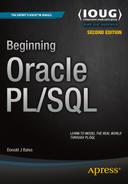Contents
Introduction (The Big Picture)
An Entity-Relationship Diagram
Data Definition Language (DDL)
It’s Your Turn to Create a Table
It’s Your Turn to Create an Index
It’s Your Turn to Create a Constraint
It’s Your Turn to Insert with Values
It’s Your Turn to Insert with Select
It’s Your Turn to Create Code Tables
It’s Your Turn to Create Content Tables
It’s Your Turn to Create Intersection Tables
![]() Chapter 2: Blocks, Functions, and Procedures
Chapter 2: Blocks, Functions, and Procedures
It’s Your Turn to Create a Function
It’s Your Turn to Create a Procedure
Create a Package Specification
It’s Your Turn to Create a Package Specification
It’s Your Turn to Create a Package Body
![]() Chapter 3: Types, Variables, and Scope
Chapter 3: Types, Variables, and Scope
It’s Your Turn to Declare Variables
It’s Your Turn to Scope Things Out
It’s Your Turn to Declare Parameters
![]() Chapter 4: Single Row Processing
Chapter 4: Single Row Processing
Catching a DUP_VAL_ON_INDEX Exception
Using PL/SQL to Predetect a Duplicate
IF I Don’t Tell You Now, When ELSE Can I?
Using SQL to Predetect a Duplicate
Using SQL to Perform Complex Updates
![]() Chapter 5: Multirow Processing
Chapter 5: Multirow Processing
Fetching Rows from a Cursor Manually
It’s Your Turn to Fetch Manually
Fetching Rows from a Cursor Automatically
It’s Your Turn to Fetch Automatically
Bulk Collect with a Select Statement
It’s Your Turn to Bulk Collect
![]() Chapter 6: Object-Relational SQL
Chapter 6: Object-Relational SQL
Create a User-Defined Type Specification
Create a User-Defined Type Implementation
It’s Your Turn to Create a User-Defined Type
It’s Your Turn to Create an Object View
It’s Your Turn to Create an Object Table
It’s Your Turn to Prove There’s No Impedance Mismatch
It’s Your Turn to Use put_line( )
It’s Your Turn to Use Debug Logging
Debugging with Oracle SQL Developer
Debugging with TOAD for Oracle
It’s Your Turn to Use a Debugger
It’s Your Turn to Use Explain Plan
It’s Your Turn to Create a Testing Tool
It’s Your Turn to Test a Code Table Package
Testing a Content Table Package
It’s Your Turn to Test a Content Table Package
Testing an Intersection Table Package
It’s Your Turn to Test an Intersection Table Package
It’s Your Turn to Automate Test Processing
GUI Development Environment Tools
Rules for Documentation Comments
A Text-Based Documentation Formatting Tool
Accessing Documentation on Demand
It’s Your Turn to Access Documentation on Demand
An HTML-Based Documentation Formatting Tool
Generating Distributable Documentation
It’s Your Turn to Generate Distributable Documentation
![]() Appendix A: How to Download, Install, and Use Oracle
Appendix A: How to Download, Install, and Use Oracle
How to Download Oracle Database Software
How to Install Oracle Database Software
How to Download This Book’s Source Code
How to Write a SQL*Plus Script
How to Execute a SQL*Plus Script
